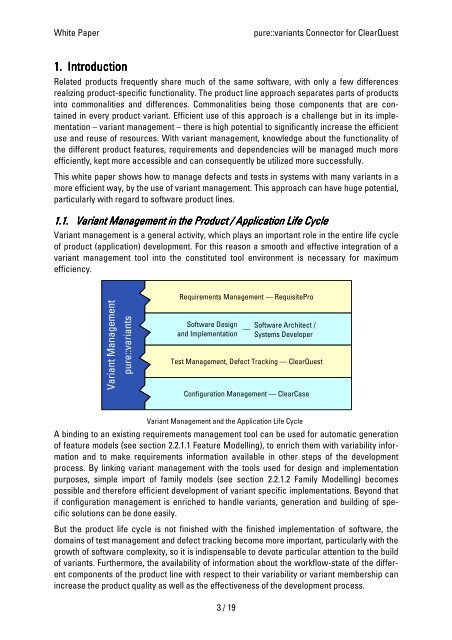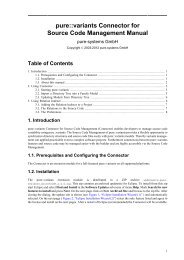White Paper - pure-systems GmbH
White Paper - pure-systems GmbH
White Paper - pure-systems GmbH
Create successful ePaper yourself
Turn your PDF publications into a flip-book with our unique Google optimized e-Paper software.
<strong>White</strong> <strong>Paper</strong> <strong>pure</strong>::variants Connector for ClearQuest<br />
1. 1. Introd Introduction<br />
Introd Introduction<br />
uction<br />
Related products frequently share much of the same software, with only a few differences<br />
realizing product-specific functionality. The product line approach separates parts of products<br />
into commonalities and differences. Commonalities being those components that are contained<br />
in every product variant. Efficient use of this approach is a challenge but in its implementation<br />
– variant management – there is high potential to significantly increase the efficient<br />
use and reuse of resources. With variant management, knowledge about the functionality of<br />
the different product features, requirements and dependencies will be managed much more<br />
efficiently, kept more accessible and can consequently be utilized more successfully.<br />
This white paper shows how to manage defects and tests in <strong>systems</strong> with many variants in a<br />
more efficient way, by the use of variant management. This approach can have huge potential,<br />
particularly with regard to software product lines.<br />
1.1. 1.1. 1.1. 1.1. Variant Variant Variant Variant Management Management Management Management in in in in the the the the Product Product Product Product / / / / Application Application Application Application Life Life Life Life Cyc CC<br />
Cycle<br />
yc ycle<br />
le le<br />
Variant management is a general activity, which plays an important role in the entire life cycle<br />
of product (application) development. For this reason a smooth and effective integration of a<br />
variant management tool into the constituted tool environment is necessary for maximum<br />
efficiency.<br />
Variant Management<br />
<strong>pure</strong>::variants<br />
Requirements Management — RequisitePro<br />
Software Design<br />
and Implementation<br />
Variant Management and the Application Life Cycle<br />
A binding to an existing requirements management tool can be used for automatic generation<br />
of feature models (see section 2.2.1.1 Feature Modelling), to enrich them with variability information<br />
and to make requirements information available in other steps of the development<br />
process. By linking variant management with the tools used for design and implementation<br />
purposes, simple import of family models (see section 2.2.1.2 Family Modelling) becomes<br />
possible and therefore efficient development of variant specific implementations. Beyond that<br />
if configuration management is enriched to handle variants, generation and building of specific<br />
solutions can be done easily.<br />
But the product life cycle is not finished with the finished implementation of software, the<br />
domains of test management and defect tracking become more important, particularly with the<br />
growth of software complexity, so it is indispensable to devote particular attention to the build<br />
of variants. Furthermore, the availability of information about the workflow-state of the different<br />
components of the product line with respect to their variability or variant membership can<br />
increase the product quality as well as the effectiveness of the development process.<br />
3 / 19<br />
—<br />
Software Architect /<br />
Systems Developer<br />
Test Management, Defect Tracking — ClearQuest<br />
Configuration Management — ClearCase




